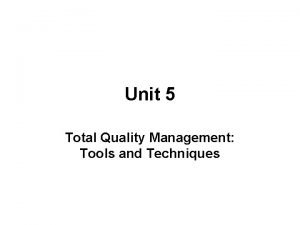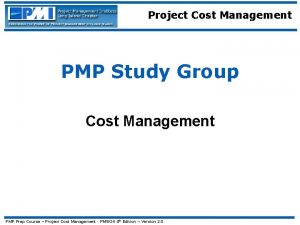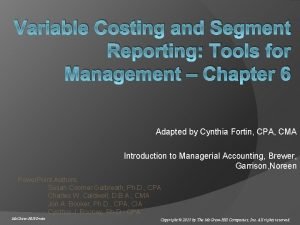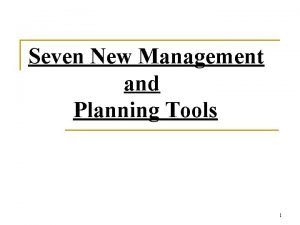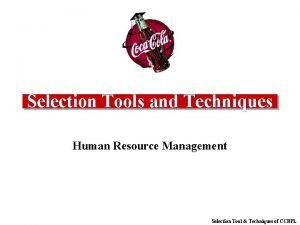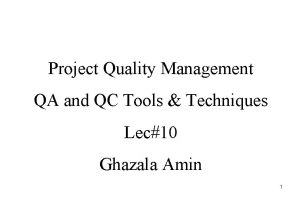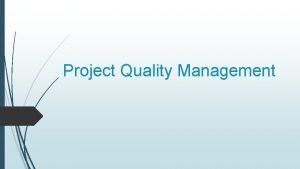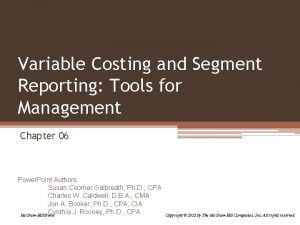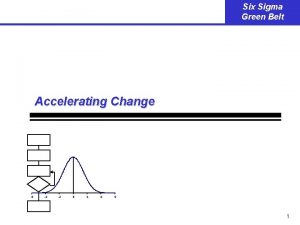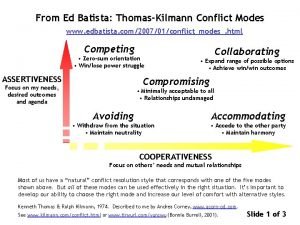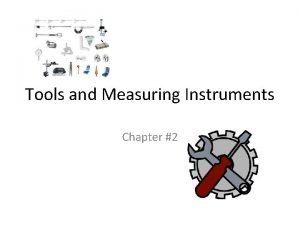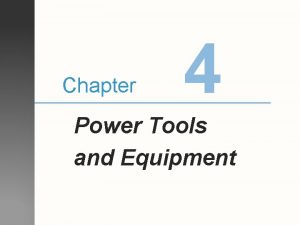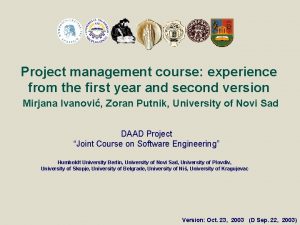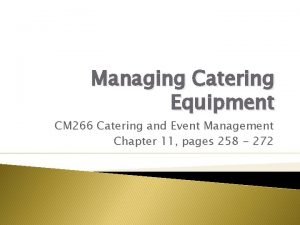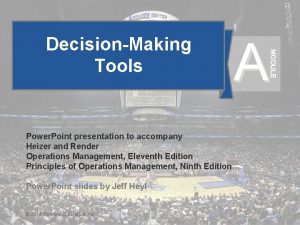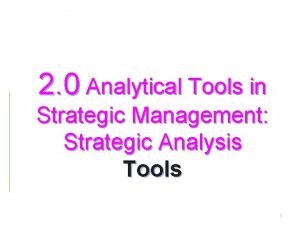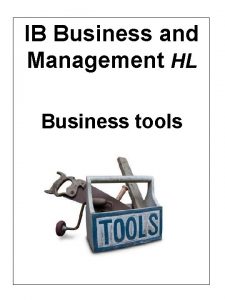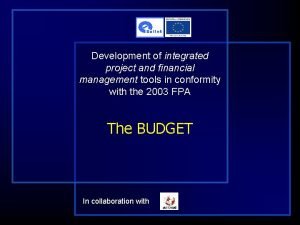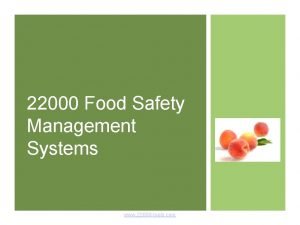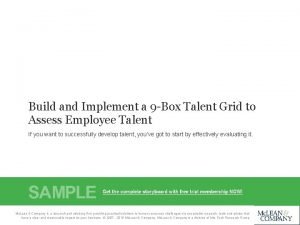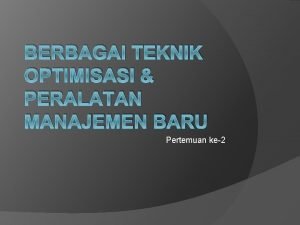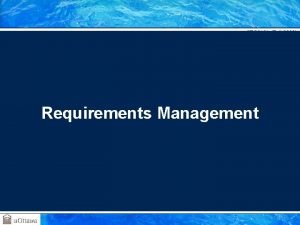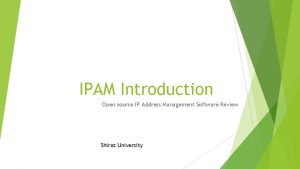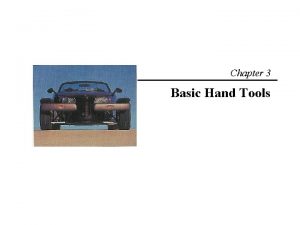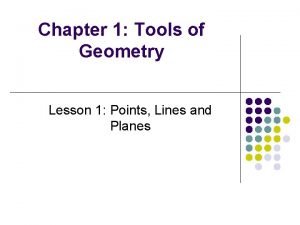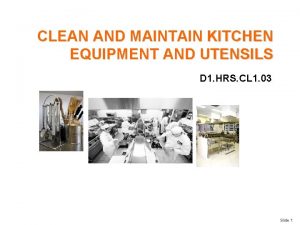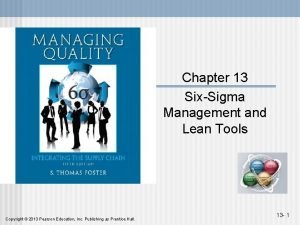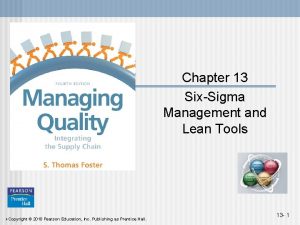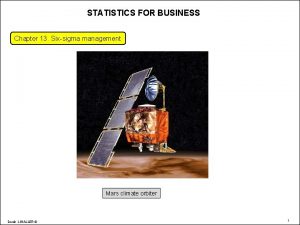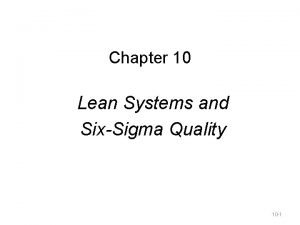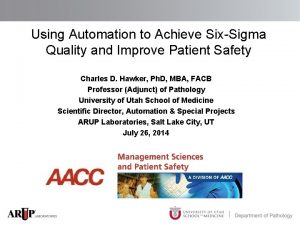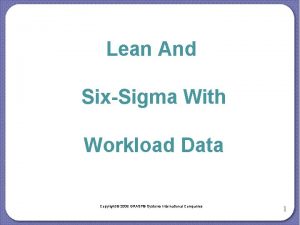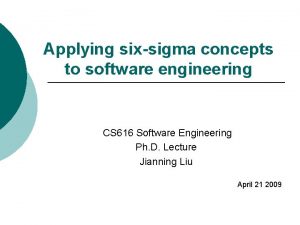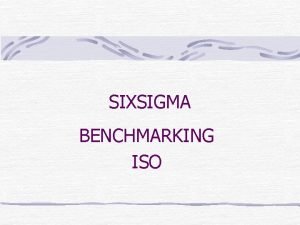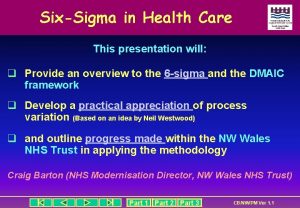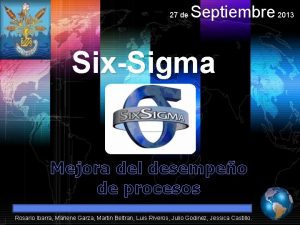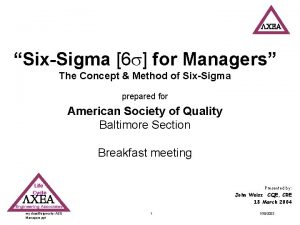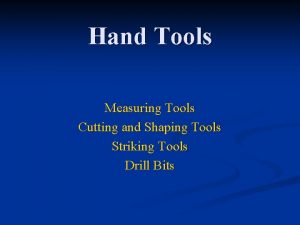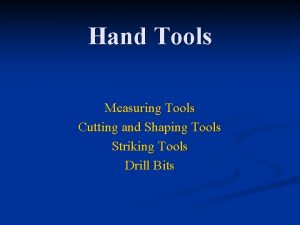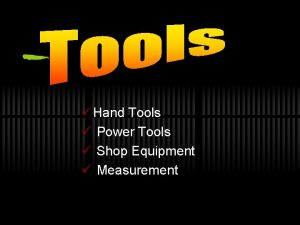Chapter 14 SixSigma Management and Tools S Thomas





















































- Slides: 53

Chapter 14 Six-Sigma Management and Tools S. Thomas Foster, Jr. Boise State University Power. Point prepared by Dave Magee University of Kentucky Lexington Community College © 2004 Prentice-Hall

Chapter Overview Slide 1 of 2 • • What is Six Sigma? Organizing Six Sigma DMAIC Overview Define Phase Measure Phase Analyze Phase Improve Phase Control Phase Managing Quality: An Integrative Approach; 2 nd Edition © 2004 Prentice-Hall Slide 14 -2

Chapter Overview Slide 2 of 2 • • • Taguchi Design of Experiments Background of the Taguchi Method The Taguchi Process Design for Six Sigma Lensing Six Sigma From A Contingency Perspective Managing Quality: An Integrative Approach; 2 nd Edition © 2004 Prentice-Hall Slide 14 -3

Differences of Six Sigma from Traditional Continuous Improvement • Six Sigma represents a well thought out packaging of quality tools and philosophies in an honest effort to provide rigor and repeatability to quality improvement efforts. • Six Sigma is much more cost reduction-oriented than traditional continuous improvement. • Six Sigma is organized around creating champions, black belts, green belts, and in some situations, yellow belts. Managing Quality: An Integrative Approach; 2 nd Edition © 2004 Prentice-Hall Slide 14 -4

What Is Six Sigma? Slide 1 of 4 • Sigma stands for the Greek symbol σ that designates a standard deviation in statistics. • Six refers to the number of standard deviations from a mean specifications should be. • Began at Motorola in 1982 as an effort to reduce costs and improve quality. • It now involves planning, organization, training, human resources planning, and pay-for-knowledge. It requires both organizational and individual cooperation to achieve a goal. Managing Quality: An Integrative Approach; 2 nd Edition © 2004 Prentice-Hall Slide 14 -5

What Is Six Sigma? Slide 2 of 4 Six-Sigma Variation σ σ 3 -sigma producing some product out of specification Managing Quality: An Integrative Approach; 2 nd Edition Figure 14. 4 σ σ 6 -sigma producing almost no product out of specification © 2004 Prentice-Hall Slide 14 -6

What Is Six Sigma? Slide 3 of 4 Sigma Levels and ppm Defects Sigma Level Long-Term ppm* Defects 1 2 3 4 5 6 691, 462 308, 538 66, 807 6, 210 233 3. 4 *ppm = parts-per-million Managing Quality: An Integrative Approach; 2 nd Edition © 2004 Prentice-Hall Slide 14 -7

What Is Six Sigma? Slide 4 of 4 Six Sigma Effectiveness Outside specialists (Less than 1%) Six Sigma (Less than 90%) Basic Tools of Quality (90%) Managing Quality: An Integrative Approach; 2 nd Edition © 2004 Prentice-Hall Slide 14 -8

Organizing Six Sigma Slide 1 of 5 • Cost of training can run $10, 000 to $16, 000 for a single black belt • Expected returns from projects can run into the $100’s of thousands • Key Players in Six Sigma Efforts – – – Champion Master black belt Black belt Green belt Yellow belt Managing Quality: An Integrative Approach; 2 nd Edition © 2004 Prentice-Hall Slide 14 -9

Organizing Six Sigma Slide 2 of 5 • Champion – Job is to work with black belts and potential black belts to identify possible projects. – Provides continuing support for the project and validates the results at the end of the project. – Would probably be the CEO in smaller companies and a senior VP in larger companies. • Master Black Belt – Experienced black belts who serve as mentors and trainers for new black belts. – Brings training in-house and can reduce costs. Managing Quality: An Integrative Approach; 2 nd Edition © 2004 Prentice-Hall Slide 14 -10

Organizing Six Sigma Slide 3 of 5 Champion Decision Making VOB VOC VOE IDEAS Financial Data Scarce Resource Blackbelt Projects Managing Quality: An Integrative Approach; 2 nd Edition Figure 14. 3 Strategic Direction Champion © 2004 Prentice-Hall Slide 14 -11

Organizing Six Sigma Slide 4 of 5 • Black Belt – Key to Six Sigma – Specially trained individuals who are committed fulltime to completing cost reduction projects. – Training usually lasts about 4 months. – Each project lasts from 2 months to a year depending on the project scope. – Individuals usually spend about two years as a black belt and are then moved into management jobs. Managing Quality: An Integrative Approach; 2 nd Edition © 2004 Prentice-Hall Slide 14 -12

Organizing Six Sigma Slide 5 of 5 • Green Belt – Trained in basic quality tools and work in teams to improve quality. – Assigned part-time to work on process and design improvement. – In some cases, activities are the same as black belts. – In other companies, green belts are involved in less critical projects. • Yellow Belts – Some companies have employees who are familiarized with improvement processes. Managing Quality: An Integrative Approach; 2 nd Edition © 2004 Prentice-Hall Slide 14 -13

DMAIC Overview Slide 1 of 2 • DMAIC Process – Very similar to the PDCA cycle. • DMAIC Phases – – – Define Measure Analyze Improve Control Managing Quality: An Integrative Approach; 2 nd Edition © 2004 Prentice-Hall Slide 14 -14

DMAIC Overview Slide 2 of 2 Figure 14. 4 Overview of Six Sigma Process Define Measure • Business Case • Project Desirability Matrix • Problem/Objective Statement • Primary/Secondary Metric • Change Management • VOC/QFD • SIPOC • Process Mapping Analyze Improve • Graphical Data Analysis • Multi-Vari Analysis • Inferential Statistics • Hypothesis Tests • Correlation • Regression • Process Modeling and Simulation • XY Matrix • Process FMEA • Basic Statistics • Decision-Making • Non-Normal Data Graphical Analysis • Measurement System Analysis • Process Capability Control • Solution Selection • Solution Implementation • Control Plans • Control Charts • Hypothesis Tests • Process Capability Assessment • Best Practice Sharing/Translation • Hypothesis Tests • Design of Experiments (DOE) • Advanced Regression • Process Modeling and Simulation • Pilot and Test Managing Quality: An Integrative Approach; 2 nd Edition © 2004 Prentice-Hall Slide 14 -15

Define Phase Slide 1 of 7 • Define Phase – Projects are identified and selected. – Project selection is performed under the direction and with the participation of the champion – Master black belts and black belts or green belts are also involved in selection. • Phases of the Define Phase – – Developing the business case. Project evaluation Pareto analysis Project definition Managing Quality: An Integrative Approach; 2 nd Edition © 2004 Prentice-Hall Slide 14 -16

Define Phase Slide 2 of 7 • Developing the Business Case includes: – Identifying a group of possible projects – Writing the business case – Stratifying the business case into problem statement and objective statement. Managing Quality: An Integrative Approach; 2 nd Edition © 2004 Prentice-Hall Slide 14 -17

Define Phase Slide 3 of 7 • The mnemonic device “RUMBA” is used to check the efficacy of a business case. – Realistic - Are the goals attainable, is the time line feasible? – Understandable - Do I understand the case? – Measurable - Do we show the measures? – Believable - That is a lot of money. Can it be done? – Actionable - Can it be implemented? • If the business case meets all of these requirements, it probably will be a good project. Managing Quality: An Integrative Approach; 2 nd Edition © 2004 Prentice-Hall Slide 14 -18

Define Phase Slide 4 of 7 • Project Evaluation – There are several methods for evaluating a project including risk and return assessment. • Risk and Return Assessment – Risk assessment evaluates a potential project across several dimensions to establish an overall risk factor for the project which will be used to determine the attractiveness of the project. – Project return assessment evaluates a potential project on 3 dimensions - growth, urgency, and impact. – The risk and return scores are placed on a grid to determine the attractiveness of the potential project. Managing Quality: An Integrative Approach; 2 nd Edition © 2004 Prentice-Hall Slide 14 -19

Define Phase Slide 5 of 7 Figure 14. 7 Project Risk and Return 100 90 Return Factor 80 Stars ? Low hanging fruit Dogs 70 60 50 40 30 20 10 0 0 10 20 30 40 50 60 Risk Factor Managing Quality: An Integrative Approach; 2 nd Edition 70 80 © 2004 Prentice-Hall 90 100 Slide 14 -20

Define Phase Slide 6 of 7 • Pareto Analysis – Part of the responsibility of the champion is to perform a cost of poor quality (COPQ) analysis. – This is based on the PAF categorization of costs discussed in Chapter 4. – Performing a study of internal and external failure costs will help to determine where the most benefit can be found. • Problem Definition – Project definition consists of a problem statement, project goals/objectives, primary metrics, secondary metrics, and team member identification. Managing Quality: An Integrative Approach; 2 nd Edition © 2004 Prentice-Hall Slide 14 -21

Define Phase Slide 7 of 7 Problem Definition Figure 14. 9 Problem Statement: In 2002, plant A lost $5. 6 million on COPQ. Of this, almost $3. 5 million occurred in operation 2. This has resulted in a loss of profitability for the firm. Project Goals/Objective: Reduce COPQ for operation 2 by 30% by year-end. Primary Metrics: - COPQ - Rework (% of sales) - Scrap (% of sales) Secondary Metrics: - Downtime for process - Plant sales - Labor productivity Team Members: Pat Shannon Phillip Fry Lyman Gallup Jerry La. Cava Managing Quality: An Integrative Approach; 2 nd Edition © 2004 Prentice-Hall Slide 14 -22

Measure Phase Slide 1 of 4 • Two Major Steps in the Measure Phase – Selecting process outcomes – Verifying measurements • Measure Phase Tools – – – Process Map XY Matrix FMEA Gage R&R Capability Assessment Managing Quality: An Integrative Approach; 2 nd Edition © 2004 Prentice-Hall Slide 14 -23

Measure Phase Slide 2 of 4 • Selecting Process Outcomes – To define process outcomes, you first need to understand the process. This involves process mapping. A process map is a flowchart with responsibility. The goal with a process map is to identify non-value added activities. – Two important measures that are monitored are defects per unit (DPU) and defects per million opportunities (DPMO). – The XY matrix is used to identify inputs (X’s) and outputs (Y’s) from a project you have mapped and are desiring to pursue. Managing Quality: An Integrative Approach; 2 nd Edition © 2004 Prentice-Hall Slide 14 -24

Measure Phase Slide 3 of 4 • Verifying Measurements – It is necessary to use gauges, calipers and other tools when measuring critical characteristics of processes. – Measurement system analysis (MSA) is used to determine if measurements are consistent. – Product and process capability analysis is another approach for verifying measurements. – Gage Repeatability and Reproducibility Analysis (Gage R&R) is the most commonly used MSA. Managing Quality: An Integrative Approach; 2 nd Edition © 2004 Prentice-Hall Slide 14 -25

Measure Phase Slide 4 of 4 • Verifying Measurements (continued) – Reasons for problems in measurement • • The measurement gauges are faulty. Operators are using gauges improperly. Training in measurement procedures is lacking. The gauge is calibrated incorrectly. – Statistical experiments using analysis of variance (ANOVA) are useful in performing Gage R&R. – Two-way ANOVA is used to determine whether variation comes from the part being measured, differences in operator measurements, or from the measurement instrument. Managing Quality: An Integrative Approach; 2 nd Edition © 2004 Prentice-Hall Slide 14 -26

Analyze Phase Slide 1 of 4 • Analyze Phase – Involves gathering and analyzing data relative to a particular Black belt project. • Steps in the Analyze Phase – Define your performance objectives. – Identify independent variables (X’s). – Analyze sources of variability. Managing Quality: An Integrative Approach; 2 nd Edition © 2004 Prentice-Hall Slide 14 -27

Analyze Phase Slide 2 of 4 • Defining Objectives – Attempting to determine what characteristics of the process need to be changed to achieve improvement. – Capability analysis is reviewed to determine where the processes are incapable and prioritized in order of importance. Managing Quality: An Integrative Approach; 2 nd Edition © 2004 Prentice-Hall Slide 14 -28

Analyze Phase Slide 3 of 4 • Identifying X’s – This involves identifying independent variables where data will be gathered. – These variables significantly contribute to process or product variation. – Primary tools used in identifying X’s • • Process maps XY matrices Brainstorming FMEA Managing Quality: An Integrative Approach; 2 nd Edition © 2004 Prentice-Hall Slide 14 -29

Analyze Phase Slide 4 of 4 • Analyzing Sources of Variation – The goal of this step is to use visual and statistical tools to better understand the relationships between dependent and independent variables (X’s and Y’s) for use in future experimentation. – Tools for Analyzing Sources of Variation • • • Histograms Box plots Scatter plots Regression analysis Hypothesis tests Managing Quality: An Integrative Approach; 2 nd Edition © 2004 Prentice-Hall Slide 14 -30

Improve Phase • Improve Phase of the DMAIC Process – Involves off-line experimentation. • Off-Line Experimentation – Involves studying the variables we have identified and using analysis of variance to determine whether these independent variables significantly affect variation in our dependent variables. – The Taguchi method is an important method for performing off-line experiments. Managing Quality: An Integrative Approach; 2 nd Edition © 2004 Prentice-Hall Slide 14 -31

Control Phase • Control Phase of the DMAIC Process – Involves managing the improved process using process charts. – Process charts were covered in Chapters 12 and 13 Managing Quality: An Integrative Approach; 2 nd Edition © 2004 Prentice-Hall Slide 14 -32

Taguchi Design of Experiments Slide 1 of 3 • Taguchi Method – A standardized approach for determining the best combination of inputs to produce a product or service. – This is accomplished through design of experiments (DOE) for determining parameters. – It provides a method for quantitatively identifying just the right ingredients that go together to make a highquality product or service. Managing Quality: An Integrative Approach; 2 nd Edition © 2004 Prentice-Hall Slide 14 -33

Taguchi Design of Experiments Slide 2 of 3 • Robust Design – The Taguchi concept of robust design states that products and services should be designed so that they are inherently defect free and insensitive to random variation. – Taguchi’s approach for creating robust design is through a three-step method consisting of concept design, parameter design, and tolerance design. • Concept design – The process of examining competing technologies to produce a product. – Includes process technology and process design choices. Managing Quality: An Integrative Approach; 2 nd Edition © 2004 Prentice-Hall Slide 14 -34

Taguchi Design of Experiments Slide 3 of 3 • Parameter design – The selection of control factors and the determination of optimal levels for each of the factors. – Control factors are those variables in a process that management can manipulate. – Optimal levels are the targets or measurements for performance. • Tolerance design – Deals with developing specification limits. – Occurs after parameter design has been used to reduce variation and the resulting improvement has been insufficient. Managing Quality: An Integrative Approach; 2 nd Edition © 2004 Prentice-Hall Slide 14 -35

Background of the Taguchi Method Slide 1 of 6 • History and Impact – The Taguchi method was first introduced by Dr. Genichi Taguchi to AT&T Bell Laboratories in 1980. – Thanks to its wide acceptance and utilization, the Taguchi method for improving quality is now commonly views as comparable in importance to statistical process control(SPC), the Deming approach, and the Japanese concept of total quality control. Managing Quality: An Integrative Approach; 2 nd Edition © 2004 Prentice-Hall Slide 14 -36

Background of the Taguchi Method Slide 2 of 6 • Taguchi Definition of Quality – In Taguchi terms, ideal quality refers to a reference point or target value for determining the quality level of a product or service. – Ideal quality is delivered if a product or tangible service performs its intended function throughout its projected life under reasonable operating conditions without harmful side effects. Managing Quality: An Integrative Approach; 2 nd Edition © 2004 Prentice-Hall Slide 14 -37

Background of the Taguchi Method Slide 3 of 6 • Quality Loss Function – If a measurement is taken of the critical product characteristic and it is within the specification limits, the traditional conclusion was that it wasn’t a problem. – However, if it is closer to being out of specification than to being at the target measurement, it might cause a problem. Taguchi calls this potential for problem a potential loss to society. – Loss to society is the cost of a deviation from a target value. Managing Quality: An Integrative Approach; 2 nd Edition © 2004 Prentice-Hall Slide 14 -38

Background of the Taguchi Method Slide 4 of 6 Classical QC-Step Function Figure 14. 16 Q(c) Scrap Cost LSL USL Target A Managing Quality: An Integrative Approach; 2 nd Edition © 2004 Prentice-Hall Slide 14 -39

Background of the Taguchi Method Slide 5 of 6 • Quality Loss Function (continued) – To quantify loss to society, Taguchi used the concept of a quadratic loss function. – Any variation from the target of six (where T = 6) results in some loss to the company. – The quality loss function focuses on the economic and societal penalties incurred as a result of purchasing a nonconforming product. – Losses may include maintenance costs, failure costs, ill effects to the environment such as pollution, or excessive costs of operating the product. Managing Quality: An Integrative Approach; 2 nd Edition © 2004 Prentice-Hall Slide 14 -40

Background of the Taguchi Method Slide 6 of 6 Taguchi Quadratic Loss Function Managing Quality: An Integrative Approach; 2 nd Edition © 2004 Prentice-Hall Figure 14. 17 Slide 14 -41

The Taguchi Process Slide 1 of 6 Taguchi Process Managing Quality: An Integrative Approach; 2 nd Edition © 2004 Prentice-Hall Figure 14. 18 Slide 14 -42

The Taguchi Process Slide 2 of 6 • Step 1: Problem Identification – The production problem must be identified. The problem may have to do with the product process or the service itself. • Step 2: Brainstorming Session – To identify variables that have a critical affect on service or product quality takes place. – The critical variables identified in the brainstorming sessions are referred to by Taguchi as factors. – These may be identified as either control factors (variables that are under the control of management) or noise factors (uncontrollable variation). Managing Quality: An Integrative Approach; 2 nd Edition © 2004 Prentice-Hall Slide 14 -43

The Taguchi Process Slide 3 of 6 • Step 3: Experimental Design – Using the factors, factor levels, and objectives from the brainstorming session, the experiment is designed. – The Taguchi method uses off-line experimentation as a means of improving quality. – This contrasts with traditional on-line (in process) quality measurement. Managing Quality: An Integrative Approach; 2 nd Edition © 2004 Prentice-Hall Slide 14 -44

The Taguchi Process Slide 4 of 6 • Step 4: Experimentation – There are different Taguchi analysis approaches that use quantitatively rigorous techniques such as analysis of variance (ANOVA), signal-to-noise ratios (S/N), and response charts. These approaches, although not always theoretically sound, are useful in engineering related projects involving engineered specifications, torques, and tolerances. Managing Quality: An Integrative Approach; 2 nd Edition © 2004 Prentice-Hall Slide 14 -45

The Taguchi Process Slide 5 of 6 • Step 5: Analysis – Experimentation is used to identify the factors that result in closest-to-target performance. – If interactions between factors are evident, two alternatives are possible. • Either ignore the interactions (there is inherent risk to this approach) • Provided the cost is not prohibitive, run a full factorial experiment to detect interactions. – The full factorial experiment tests all possible interactions among variables. Managing Quality: An Integrative Approach; 2 nd Edition © 2004 Prentice-Hall Slide 14 -46

The Taguchi Process Slide 6 of 6 • Step 6: Confirming Experiment – Once the optimal levels for each of the factors have been determined, a confirming experiment with factors set at the optimal levels should be conducted to validate the earlier results. – If earlier results are not validated, the experiment may have somehow been significantly flawed. – If results vary from those expected, interactions also may be present, and the experiment should, therefore, be repeated. Managing Quality: An Integrative Approach; 2 nd Edition © 2004 Prentice-Hall Slide 14 -47

Design for Six Sigma Slide 1 of 2 • Design for Six Sigma (DFSS) – Used in designing new products and services with high performance as measured by customer-based critical to quality metrics. – Requires DMADV methodology instead of DMAIC. • • • Design Measure Analyze Design Verify – DMADV pertains to developing new processes and products, whereas DMAIC pertains to improving existing processes and products. Managing Quality: An Integrative Approach; 2 nd Edition © 2004 Prentice-Hall Slide 14 -48

Design for Six Sigma Slide 2 of 2 • Design for Six Sigma (DFSS) – IDOV is another method. • • Identify Design Optimize Verify – IDOV is focused on final engineering design optimization. – These methods are customer focused, encompassing the entire business-to-market process and pertain to both services and products. Managing Quality: An Integrative Approach; 2 nd Edition © 2004 Prentice-Hall Slide 14 -49

Lensing Six Sigma from a Contingency Perspective Slide 1 of 2 • Six Sigma – Very popular approach for improving the robustness of designs and processes. – Very technical and requires special expertise. – Can be useful for companies that need to improve their cost and efficiency through quality efforts. • Requirements for Six Sigma Success – – Culture Leadership Commitment Availability of data for projects Managing Quality: An Integrative Approach; 2 nd Edition © 2004 Prentice-Hall Slide 14 -50

Lensing Six Sigma from a Contingency Perspective Slide 2 of 2 • Reasons for Six Sigma Failure – – – Lack of leadership by champions Misunderstood roles and responsibilities Lack of appropriate culture for improvement Resistance to change and the Six Sigma structure Faulty strategies for deployment Lack of data Managing Quality: An Integrative Approach; 2 nd Edition © 2004 Prentice-Hall Slide 14 -51

Summary Slide 1 of 2 • • What is Six Sigma? Organizing Six Sigma DMAIC Overview Define Phase Measure Phase Analyze Phase Improve Phase Control Phase Managing Quality: An Integrative Approach; 2 nd Edition © 2004 Prentice-Hall Slide 14 -52

Summary Slide 2 of 2 • • • Taguchi Design of Experiments Background of the Taguchi Method The Taguchi Process Design for Six Sigma Lensing Six Sigma From A Contingency Perspective Managing Quality: An Integrative Approach; 2 nd Edition © 2004 Prentice-Hall Slide 14 -53
 Forensic anthropologist vs forensic pathologist
Forensic anthropologist vs forensic pathologist Cutting tools in sewing with pictures and meaning
Cutting tools in sewing with pictures and meaning Tqm tools and techniques
Tqm tools and techniques Pmp cost management
Pmp cost management Environment management tool
Environment management tool Project management tools for ediscovery and litigation
Project management tools for ediscovery and litigation Variable costing and segment reporting
Variable costing and segment reporting Variable costing and segment reporting tools for management
Variable costing and segment reporting tools for management Variable costing and segment reporting tools for management
Variable costing and segment reporting tools for management L shaped matrix diagram
L shaped matrix diagram Human resource management tools and techniques
Human resource management tools and techniques Qcc tools and techniques
Qcc tools and techniques Project quality plan
Project quality plan Why planning is important
Why planning is important Variable costing and segment reporting tools for management
Variable costing and segment reporting tools for management Change management tools and techniques
Change management tools and techniques Thomas gordon discipline as self control
Thomas gordon discipline as self control Conflict management strategies
Conflict management strategies Dental hand instruments chapter 34
Dental hand instruments chapter 34 Chapter 10 power tools and shop equipment
Chapter 10 power tools and shop equipment The language and tools of algebra
The language and tools of algebra Top management middle management first line management
Top management middle management first line management Management pyramid
Management pyramid Middle level management
Middle level management Chapter 12 inventory management
Chapter 12 inventory management Project management tools in software engineering
Project management tools in software engineering Pcm meaning in project management
Pcm meaning in project management Exchange control panel 2010
Exchange control panel 2010 Managing catering equipment
Managing catering equipment Balance sheet management tools
Balance sheet management tools Decision making tools in management ppt
Decision making tools in management ppt Strategic analysis tools
Strategic analysis tools Child protection case management tools
Child protection case management tools Position map ib business
Position map ib business Project financial management tools
Project financial management tools Features of a good content management system
Features of a good content management system Fs22000 training
Fs22000 training Talent management tools 9 box grid
Talent management tools 9 box grid Teknik optimasi dan peralatan manajemen baru
Teknik optimasi dan peralatan manajemen baru Storage resource management tools
Storage resource management tools Requirements management tools
Requirements management tools Change management tools
Change management tools Engineering management tools
Engineering management tools Automated storage resource management
Automated storage resource management Ip address management free
Ip address management free Basic hand tools list
Basic hand tools list A natural physical drive that prevents starvation
A natural physical drive that prevents starvation Chapter 2 tools of environmental science
Chapter 2 tools of environmental science Chapter 1 tools of geometry answer key page 54
Chapter 1 tools of geometry answer key page 54 Tools of geometry chapter 1
Tools of geometry chapter 1 The basic tools of finance chapter 27
The basic tools of finance chapter 27 The basic tools of finance chapter 27
The basic tools of finance chapter 27 Chapter 2 tools of environmental science answer key
Chapter 2 tools of environmental science answer key Clean and maintain premises
Clean and maintain premises


